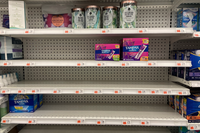Pads and tampons have been added to the list of items disrupted by supply chain shortages. Here are some tips for fellow menstruators.

Shelves running out of menstrual hygiene products.
BY STEPH BLACK
JUNE 23, 2022
There has been a recent addition to the list of items disrupted by supply chain shortages that might surprise you: menstrual hygiene products.
Menstrual products can’t be purchased using food stamps, and with the added cost of gas, it might be impossible for someone to find the products they actually need by driving to a different pharmacy or grocery store.
Shoppers have been posting pictures of bare shelves that were once filled with pads, tampons, and other menstrual products in pharmacies across the country. Currently, it’s difficult to pinpoint what exactly is causing the shortage, but it’s safe to say that the supply chain disruptions that have affected other products such as food, baby formula, and gas are contributing to the dearth of menstrual products available.
According to The Washington Post, the average cost of tampons has increased by nearly 10 percent in the past year. Some manufacturers claim that cotton and other materials have been difficult to source.
While some people might be just mildly inconvenienced by not being able to find their preferred brand or type of menstrual product, others struggle to afford the steeper prices or are unable to travel further to find the products they need in stock. Inadequate access to menstrual hygiene supplies is a matter of reproductive justice. This shortage is particularly affecting those who are already struggling to make ends meet, such as young people and people of color.
Menstrual products can’t be purchased using food stamps, and with the added cost of gas, it might be impossible for someone to find the products they actually need by driving to a different pharmacy or grocery store. Coupled with the fact that half of the states in this country impose something called a Pink Tax, which categorizes menstrual products as luxury goods, there is a growing panic among those who need these products.
The organization I Support The Girls is actively calling for donations of any tampons and pads as long as they’re sealed, even going so far as to request open boxes.
But people need menstrual supplies for more than just periods. Medication abortions induce heavy bleeding that requires a person to wear thick pads after their abortions. And, while heavy bleeding typically doesn’t occur after a surgical abortion, most patients will need to wear pads after their procedures. For those experiencing the tragedy of a miscarriage, having pads available is a critical part of healing.
As abortions become more inaccessible and more expensive, the additional burden of spending upward of $60 for one box of pads can be insurmountable. It’s also unclear how this will impact incarcerated menstruators, who already have an extraordinarily difficult time acquiring an adequate amount of menstrual hygiene products.
To me, this harkens back to the days when people were shunned for being on their period, when menstruation forced people to isolate themselves to manage their cycles. For some people, that reality never ended. In the past few years, we have made progress toward gender equity by making free menstrual products readily available in schools, libraries, and other public places. The number of people forced to stay home from school or work due to insufficient menstrual products has decreased tremendously. I can’t help but fear that a nationwide shortage of basic period products will reverse and maybe even worsen this.
It’s critical to remember that, even though there is a shortage of menstrual supplies, keeping tampons in the vagina for longer than recommended to prolong their use is dangerous.
For those who can afford to do so, switching to reusable methods could alleviate the burden from those who are unable to afford to do so. For example, menstrual cups and discs come in a variety of shapes and sizes that can be worn for up to twelve hours and washed after each use—and they can last up to ten years. And while cloth pads might take a bit of elbow grease to clean at the end of your cycle, they can replace the need for a box of pads every month. There are also plenty of online tutorials on how to make your own period products with a cotton t-shirt, needle, and thread.
I personally recently decided to commit to only using reusable menstrual products. I’ve used reusable products in the past but never completely got rid of my disposables. However, given the shortage and knowing that the cost of pads and tampons is at the very edge of my budget, I was able to make the upfront cost of buying reusable period products from a small, woman-owned business called Gladrags. This will save me money in the long run, but I know that solely relying on reusables might not be a reality for others.
For people using contraceptives, finding a form of birth control that will prevent your period entirely might also be an appealing alternative to buying single-use menstrual products.
You can donate sealed menstrual products to your local domestic violence or homeless shelters, and, if there are menstrual products available at your local pharmacy, consider only taking one box at a time—and leave some for the next person who needs them.

Steph Black
Steph Black is an abortion activist and writer based in Washington, D.C. She also writes a column, "The Activist Offering," for The Progressive. Read her work at stephblackstrategies.com
No comments:
Post a Comment